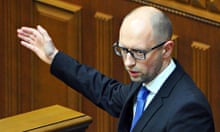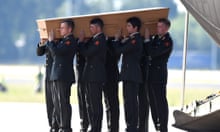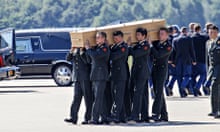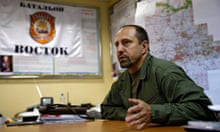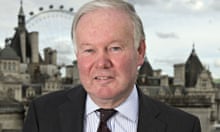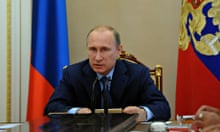Four days after the Boeing 777 came crashing down into the fields of eastern Ukraine, the flight recorders from flight MH17 were finally handed over to the Malaysians at a surreal night-time ceremony in Donetsk, while the bodies of 282 victims began a slow train journey out of the country's south-eastern conflict zone.
Almost 12 hours after negotiations with the so-called Donetsk People's Republic, a Malaysian delegation was handed the two "black boxes" – chunky devices which are in fact orange – by Alexander Borodai, the self-styled prime minister of the Donetsk People's Republic, in a late-night press conference guarded by dozens of Kalashnikov-wielding rebels, on the 11th floor of a government building in Donetsk that has been occupied by the rebels.
Before handing over the boxes Borodai took the chance to insist again that the pro-Russia rebels in east Ukraine had nothing to do with the downing of MH17 and blamed the Kiev government, which he said had "both the technical ability and the motive" to bring down the plane.
Colonel Mohamed Sakri, part of the Malaysian delegation, thanked "his excellency Mr Borodai" for agreeing to the transfer, which came after Borodai spoke personally to the Malaysian prime minister by telephone earlier in the day.
Most western capitals have accused the pro-Russia rebels of bringing down the plane using a Buk missile, possibly brought to Ukraine from Russia. Sakri refused to take questions on who might be to blame for the tragedy, and said that after the mystery of MH370 it was important to recover the black boxes this time.
"We show to the people of Malaysia that we are so serious to make sure that these things are recovered for Malaysia," he said. The Malaysian delegation, having signed documents to recover the black boxes, hoped to leave "immediately", Sakri said.
Ukraine's security services had previously released recordings of what it said were rebel leaders coordinating a ground search for the black boxes and insisting that they not be given to international leaders, as Moscow wanted to get them first. The rebels denied that the recordings were genuine.
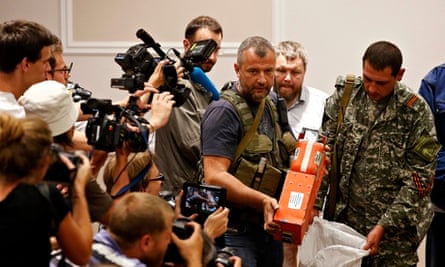
On Monday evening a train of refrigerated carriages finally rolled out of the station in the rebel-controlled city of Torez carrying bodies collected from the crash site in recent days. Borodai said the train contained the bodies of 282 of the victims as well as 87 "other body fragments".
The train arrived in Donetsk but was held up in the wake of heavy fighting around the city's train station on Monday. It eventually departed to make its way to Kharkiv in territory controlled by the Ukrainian government.
The bodies' departure from the crash site is likely to bring a small amount of respite to relatives, after a chaotic and controversial clear-up mission complicated by a military conflict rumbling nearby, the summer heat and what at times has appeared to be deliberate obstruction.
"After the crime comes the cover up," said Tony Abbott, the prime minister of Australia, which had 28 citizens on MH17. "What we have seen is evidence tampering on an industrial scale, and obviously that has to stop."
Earlier on Monday a trio of Dutch experts, the first to reach the train holding the bodies, paused, hands clasped together and heads bowed, before clambering up to the grey train carriages to inspect the interior. One of the three, Peter Van Vliet, said the experience had given him goosebumps, despite the sweltering heat.
In a whispered conversation on the station platform, observers from the Organisation for Security and Cooperation in Europe (OSCE) urged the rebels to do everything in their power to speed up the process of moving the bodies out of the conflict zone.
"This train must move today, it cannot wait any longer. It will not be good for anyone – not the experts, not the families, not you," Alexander Hug, deputy of the special monitoring mission to Ukraine, was overheard saying to the rebels.
When they reach the Ukrainian-controlled city of Kharkiv it is expected that the bodies of the victims will be loaded on to a transport plane and flown back to the Netherlands as soon as possible. The Malaysian delegation confirmed that all the bodies would be flown to the Netherlands and would only then be sorted by nationality.
In the early hours of Tuesday morning a C130 Hercules plane arrived in Kharkiv from the Netherlands carrying a forensics team to take charge of getting the bodies out of Ukraine. Australia said it had sent a C17 plane to help with the retrieval.
Also on Tuesday Malaysia Airlines was forced to answer further criticism that in diverting planes away from Ukraine it had sent at least one flight over another conflict zone: Syria.
The airline gave the same explanation it did for MH17: that the flight path for MH004 went through airspace "not subject to restrictions" and had been approved by the International Civil Aviation Organisation. The route on which MH17 was shot down may not have been in restricted airspace but was nonetheless within 1,000ft of a no-fly zone.
There is much work still to be done in Donetsk and at the crash site itself, but renewed fighting near the city's train station between pro-government forces and rebels, which left several civilians dead on Monday, provides an additional obstacle for any international experts trying to reach the site.
Getting appropriate permissions for international experts to enter the war-torn region has proved problematic. Michael Bociurkiw, a spokesman for the OSCE, called the process a "logistical nightmare". The three Dutch specialists, who travelled from Kharkiv, said that they had been accompanied part of the way by the Ukrainian army before being passed over to an escort of rebels.
Monday's violence made Donetsk an even more daunting venue to travel for international experts hoping to examine the MH17 crash site. The city's mayor advised all residents to stay indoors, the streets were largely deserted and there were reports that damage to infrastructure meant that the city would run out of water in a matter of days.
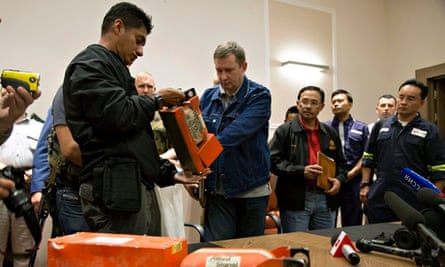
While the rebels have been heavily criticised for blocking access to the crash site, it was the Ukrainian army that seemed to be disrupting expert work on Monday as they apparently launched an offensive against rebel positions close to Donetsk railway station, as well as in other towns across the region.
The Ukrainian authorities said they were not targeting residential areas. "We are coming to the city, special assault groups are working there," Vladislav Seleznev, spokesman of anti-terrorist operation, told the Guardian. "Within city boundaries we are not using heavy artillery," he added.
However, there were a number of cases where what appeared to be Grad rocket fire had landed in residential areas. At one school building near the railway station terrified locals hid in the basement all morning, and two men were killed by shrapnel in the playground. A local named Sergei, who lives near the school, said he had helped to load dead bodies onto a truck provided by the rebels.
Adding to the sense of chaos, Andriy Lysenko, a spokesman for Ukraine's national security council in Kiev, denied that the Ukrainian army was responsible for explosions in central Donetsk but said small groups of partisans could be engaging the rebels.
"We have strict orders not to use air strikes and artillery in the city. If there is fighting in the city, we have information that there is a small self-organised group who are fighting with the terrorists," he said.
The Ukrainian president ordered a ceasefire across a 40km (24 mile) radius from the crash site, but this does not include Donetsk, which is farther out.
The fighting near the station was an "added complication" for moving the train with the bodies, said the OSCE. They also said the body bags inside the train were tagged using a numbering system and stored at a temperature between 0C and -5C. Experts from several countries including the UK are in Kharkiv. The Dutch prime minister, Mark Rutte, said the swift return of the bodies was his "number one priority" at a news conference on Monday.
With most of the bodies now removed from the site, attention will turn to the other tasks of the crash investigation, most importantly attempting to find some proof of what exactly brought the plane down.
David Gleave, a former aviation safety investigator, confirmed that pictures appeared to show shrapnel damage from a missile to a section of fuselage from the stricken aircraft. "The markings are consistent with something external hitting the aeroplane," he said, describing the indentations as indicative of a missile strike.
"It looks like there are markings on the external to the internal of the aircraft, meaning it's not a bomb blowing outwards. That's not the main bit where the missile hit, it's the periphery of the explosion. It looks like secondary damage."
In spite of the delay in investigators arriving at the crash site, Gleave said it would still be possible to trace the manufacturer of the missile by forensically examining bits of wreckage and human remains for chemical traces.
"I'm not convinced [the contamination of the crash site] is quite as bad as people say. If it's a missile then all the conventional stuff we need for data-gathering goes out of the window. A black box isn't going to tell you it was a missile," he said.
The cleanup operation, which has been roundly criticised by the international community who fear pro-Russia rebels are contaminating the site to cover up signs of their involvement, was cautiously praised by Van Vliet, at least when it came to the collection of the bodies.
Given the hot weather, the size of the crash site and the military operations going on in the vicinity, the operation was "very difficult" and he was impressed with the efforts of local emergency workers and volunteers, who have spent three days sifting corpses and body parts from the crash site. He added though, that the area needed a "full, forensic sweep" by proper experts.
Additional reporting by Oksana Grytsenko in Donetsk and Josh Halliday
